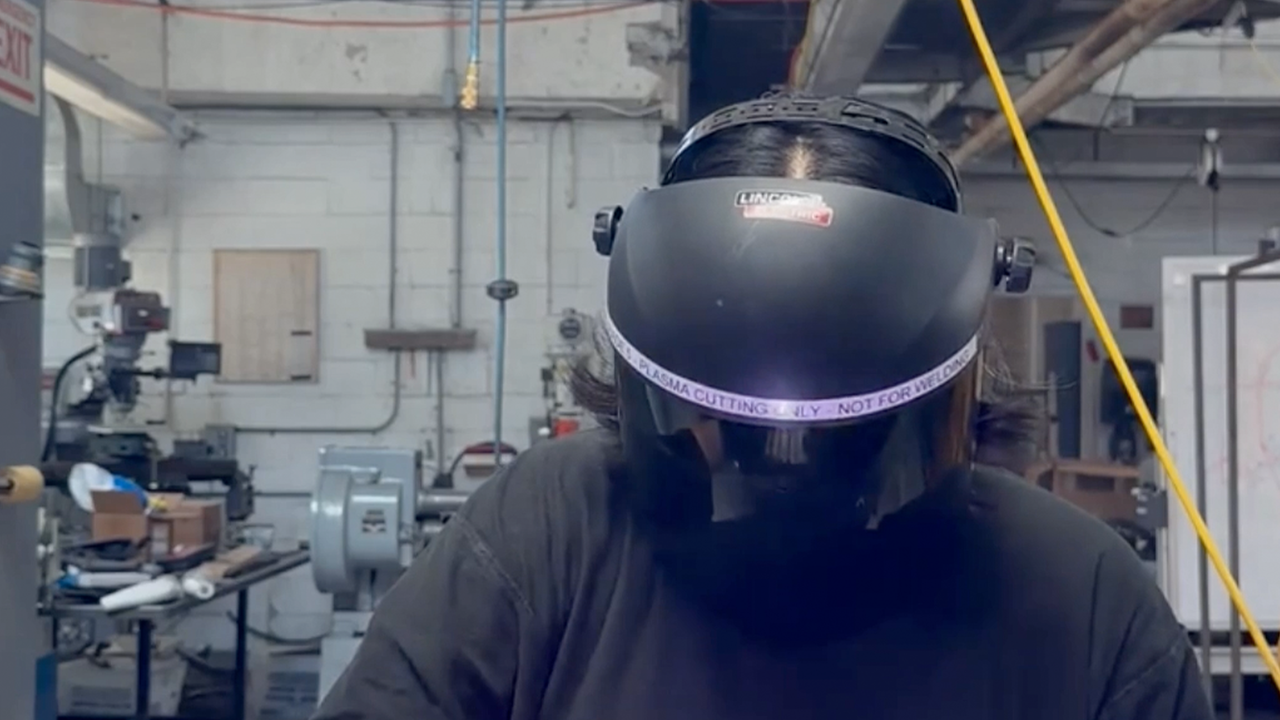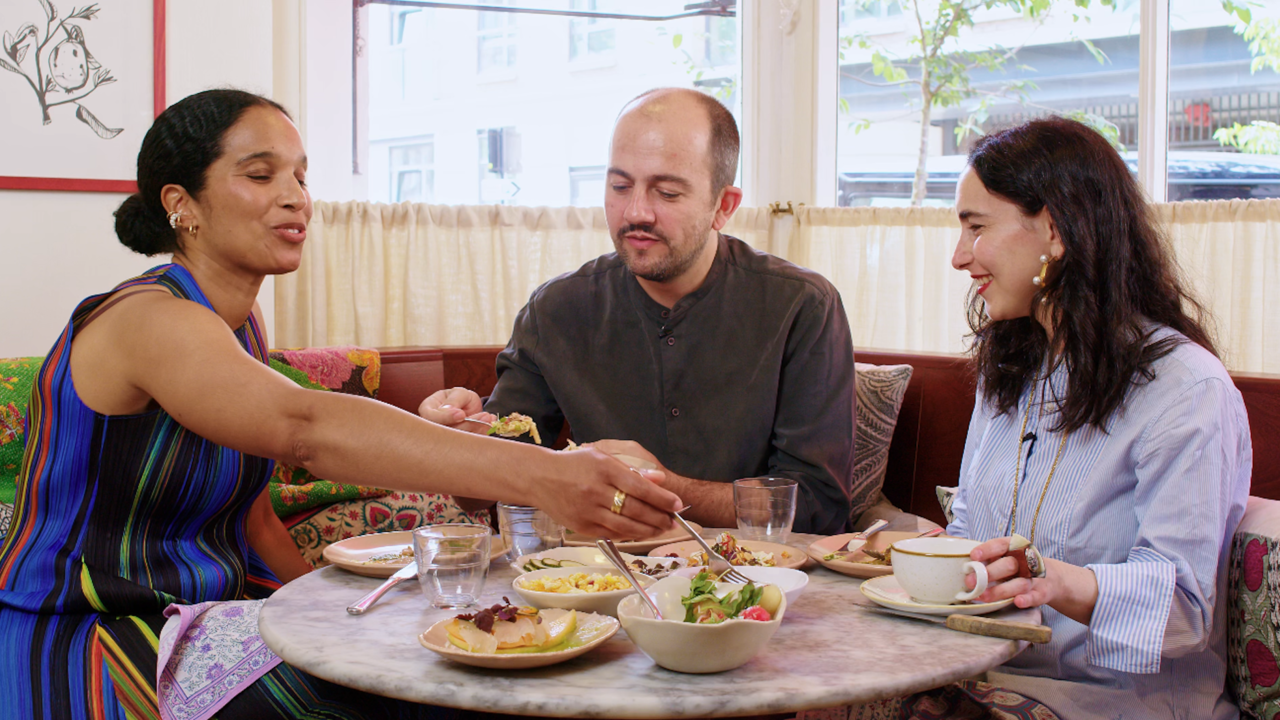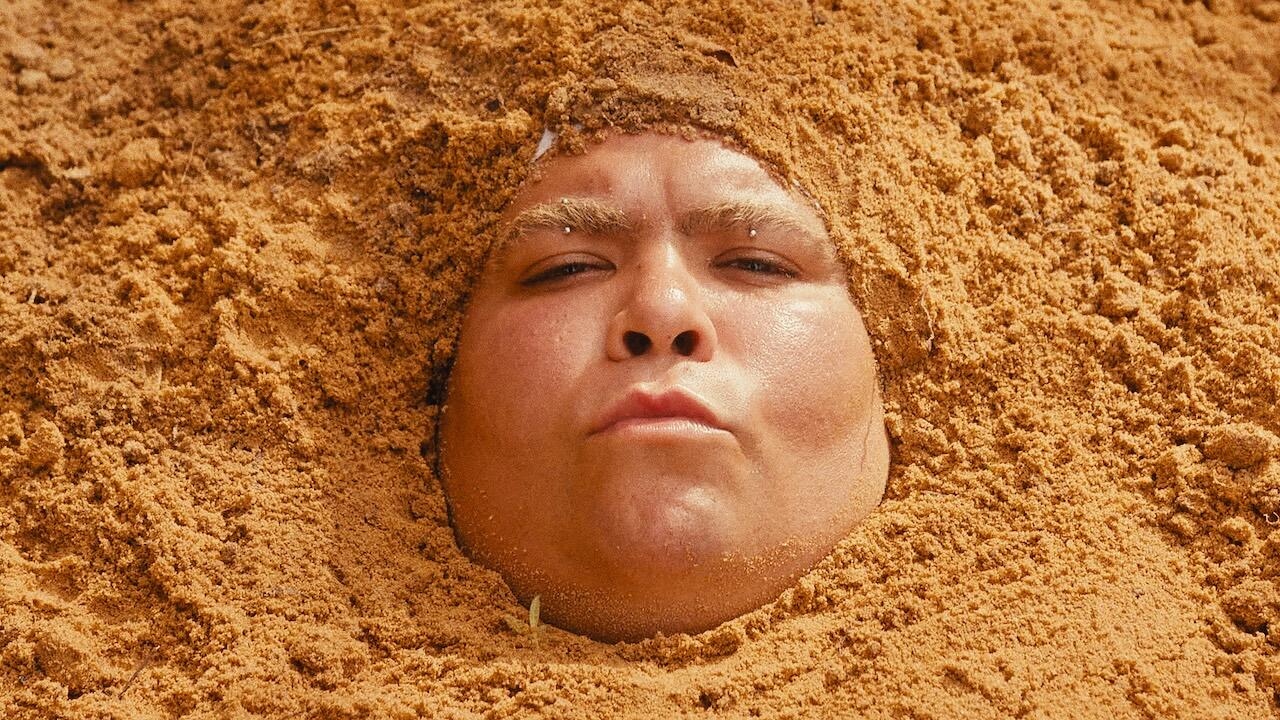Jack O’Brien’s Charged Objects
Ahead of his first institutional show at Camden Art Centre, the artist discusses how London’s architecture shapes the eroticism in his assemblages
Ahead of his first institutional show at Camden Art Centre, the artist discusses how London’s architecture shapes the eroticism in his assemblages

Edward Gillman Your forthcoming show at Camden Art Centre features a new site-specific installation, The Reward [2024], which is on a larger scale than anything you’ve ever worked on before.
Jack O’Brien The Reward is comprised of two ten-metre-long suspended spiral staircases, each wrapped in a skin of knitted stockinette – they are modelled on those staircases commonly found in commercial warehouses around South London – that serve as the show’s central motif. This form of industrial architecture has been hugely influential in my thinking and practice over the past decade – a period in which the city’s built environment has rapidly collapsed, expanded and transformed due to aggressive real-estate development.
The show considers the fraught nature of my social, economic and sexual experiences in London during the 2010s – an energy that has kept me plugged into the city’s art scene. I’m looking to evoke memories of my time in these post-industrial areas and the places that have continuously opened and closed around me: the studios I’ve worked in, the homes I’ve lived in, the bars, clubs, toilets and warehouses I’ve partied at.

EG At times, your carefully balanced sculptures appear precarious, charged with a nervous energy, as though on the brink of collapse.
JOB I often try to unpick the ‘fixed’ state of an object through challenging its materiality or structure. Weighty or seemingly inflexible construction materials – such as fence posts, concrete or exhaust vents – are frequently forced into confrontations with each other. A good example of this would be works in which I’ve joined metal with glass, as in many of my white shirt works such as Adaptation [2022]. This material juxtaposition feels particularly ‘wrong’ and creates a sense of unease. I’ve created a similar effect by wrapping mild steel in soft upholstery fabric, as I did for my 2023 show, ‘The Theatre and Its Double’, at Between Bridges in Berlin. These encounters prompt clashes between materials and objects, with the soft fibres trying to find some middle ground with impenetrable steel or hardened mortar.
Exploring these ‘meeting points’ has become a fixation: I want my work to generate a state in which everything feels charged. It’s like gay cruising: there’s something overwhelmingly erotic about the stakes being so high and fraught with the sense of unknown potential. These are the terms in which I think about queerness: rather than being a fixed and definable state, which is often commodified through a neoliberal agenda, its fragility allows for dramatic potential. This is something José Esteban Muñoz picks up on in Cruising Utopia: The Then and There of Queer Futurity [2009]. My sculptures long to expand beyond the confines of their own limitations, and to suggest new beginnings.

EG Your work often features found objects bound together in pairs or triples. For example, two cellos are sheathed in cellophane in Phaedrus [2024], while a pair of heels are wrapped with wire mesh in Ring I [2021]. This process of grouping and binding objects imbues your works with a deep sensuality and tactility.
JOB These repetitions are like sculptural palpitations, a life force that mirrors our interpersonal relationships and the myriad erotic impulses that shape them, particularly through moments of intense intimacy. Physical and emotional interactions are in constant sensual dialogue, intertwining identities and collective experiences. In Phaedrus, the cellos, closely embraced, evoke a deep connection to the human body, both through their size and the fact that, in their past lives, they were held by performers. It’s as if the objects are in a deep state of longing: as the cellos mirror and affirm each other, they create new expanded relationships not just with the viewer but with the space, the city and other surrounding entities.
In binding objects with cellophane, which is both restrictive and protective, I want to amplify intimacy and interdependence, and echo the complexities of human connection, when lovers’ identities often evolve, and even merge, in each other. Another way I engage repetition is by employing linguistic structures – such as syntax, grammar and semantics – to relay and underscore meaning and methodology to create stability.
I often try to unpick the ‘fixed’ state of an object through challenging its materiality or structure.
For example, I’ve deployed repetition as a form of punctuation, especially in my use of chrome-plated balls, reels of ribbon and aluminium pipes. Whether they’re splitting, puncturing or pinning, these elements conjoin to consolidate the disparate mass of materials that feature in the works. They also act as anchors, threading continuity and coherence through otherwise erotically charged assemblages of forms, thoughts, impulses and ideas, ultimately shaping the narrative and rhythm within the work.

EG The material interactions in your installations directly engage viewers with abstracted representations of the body – specifically, the queer male body. Can you talk more about queer materiality?
JOB I’m interested in reading materials as ‘eloquent texts’, you could say, imbued with cultural and historical meanings related to the body. I try to emphasize the fluidity and lustre of the materials I’m using, to reflect the multifaceted nature of queer experience. Shine acts as a correspondence between our desires, mirroring how surfaces in queer spaces – bar tops, dancefloors, the padding of gay sauna booths – bear the imprints of intimate encounters and collective memories, each surface telling a story of unfurling pleasure and tender vulnerabilities.
This is also reflected in my use of wooden goods carriages wrapped in industrial cellophane: for me, these symbolize the shift from agrarian to industrial economies and highlight the tensions between past, present and future. I also see the carriages as representing the queer body, historically subjected to containment and regulation. The cellophane mirrors a queer experience of visibility and marginalization, suggesting both protection and suffocation. By wrapping these objects, I’m trying to evoke an ornamental symbolism that resembles cranial, bodily, masculine physiologies, revealing physical complexity and challenging a particularly rigid idea of masculinity – and its shifting place in relation to queerness.

EG We often discuss queer culture in terms of style or history. We learn and adapt the cultures of the queer people who came before us as a way of connecting our lives to others. We think of ourselves as being part of a lineage. Which queer cultural histories have most informed your work?
JOB I often think about the lineages of queer abstraction, as it’s something I grapple with regularly, and there are many artists I see as pivotal to how I’ve anchored and expanded my work. I remember first encountering Tom Burr’s sculptures at Maureen Paley in 2017 and feeling a connection to his very stark approach to abstraction, and his exploration of gay male sexuality in both public and private spaces. There’s a directness to his work that I really appreciate, where subject matter isn’t shied away from. Burr unpacks a complex landscape of queer identity and its ever-shifting relationship to activism, visibility and marginalization. Another pivotal artist for me is Marc Camille Chaimowicz. I’m fascinated by the breadth of his practice.
I’m trying to explore a state in which everything feels charged.
I especially love the works he created directly on magazine pages to explore and decode the image and its poetic qualities. I am also fascinated by the complex connections between his work and that of the queer figures who came before him, such as Jean Genet, finding parallels through their shared experiences. I appreciate how he tackled the political through modes of melancholy and camp, blending this with a romantic and cerebral approach to gesture and materiality. He approached ornamentation and collage with an expansive lightness, using these tools to realign our relationships to space, object, image and each other.
As I’ve developed my work, I’ve increasingly found myself appreciating the methodologies that these artists employed, reassured by how tools of abstraction allow space for nuance and poetic expression. Their approaches provide me with a framework for exploring complex ideas without the constraints of representation. It’s possible to engage with politics and everyday experience, as well as the oscillations of representation, while rejecting overt legibility. Providing a new path for navigating and articulating life’s subtleties, their methodologies weave a rich tapestry of meaning that invites deeper introspection and further exploration.

EG Your work developed against a backdrop of severe economic austerity in the UK, which, in turn, produced a wave of rapid and aggressive urban development. How do you think this informed your practice?
JOB My sculptures have always needed to be collapsible, easy to move, because storage and space have been a constant concern over the past ten years. My works have therefore evolved in a way that is very purposeful – even flamboyant – in terms of staging and restaging. Initially, for instance, I used clothing, such as high heels or jeans, often fixed together with gaffer tape or cable ties. If we consider the city a stage, my sculptures function within it as dynamic props – temporal and flexible – that adapt to their surroundings, reflecting the transient and ever-changing nature of the urban environment. Recently, for my show ‘Nectar’ at Matthew Brown in Los Angeles, I made Wrest [2024], a large-scale sculpture consisting of conjoined, suspended lamp posts, sourced on the outskirts of the city, fused together with pallet netting and epoxy putty. If a work feels too laboured over in the making, it loses the energy, the malleable looseness, with which it’s been invested.
I want to amplify intimacy and interdependence, and echo the complexities of human connection.
I am trying to instil a sense of honesty into the making process, shedding light on how a work is conceived and revealing the often-tumultuous journey that has led to its creation. This approach often surpasses the restrictive pressures of presentation and hyper-production. Naivety and resourcefulness have been crucial in how I’ve coped with this period of austerity – something I see reflected in the works I’ve been making.
EG Your works often echo the forms, structures and surfaces of the built environment, but you don’t attempt to unpick the schematic histories of development. Can you talk more about how concepts of commerce and labour exist within your practice?
JOB There’s this concern in contemporary art regarding mechanical reproduction and modes of repetition within consumer culture. I’m trying to build on some of this. In my series ‘Cherry’ [2021–present], for instance, I want the works to resemble pasted images on billboards. I’ve been exploring the erotic sensibilities of hyper-capitalism, such as the commodification of desire in contemporary culture, both online and in urban spaces. The cherry, a pop icon, represents multiple forms of sensuality and eroticism within our shifting culture – from renaissance artworks to 19th-century slot machines, from sex-shop signage to online ads. Embodying both crude forms of desire and unattainable allure, the cherry serves as a marker of commerce and labour within the urban landscape.

EG Do your site-specific works attempt to challenge the structures and conventions of the institution?
JOB Institutions come with a rigid set of rules that need to be challenged or broken. By simply hanging a work on a wall, an artist can transform a gallery into a space for radical critique. I’ve always viewed criticism as emerging from within; by immersing myself in the codes and make-up of something, I can find a way to challenge and subvert it. What happens when we confront the constraints of commercialization?
Institutions come with a rigid set of rules that need to be challenged or broken.
At Frieze London in 2023, I exhibited A tyrant called love is coming [2023] alongside Volent [2023]. This first work featured an unplugged industrial fan, stripped of its original function and transformed through the addition of objects and heat-formed plastic wrapping. The work begins to subvert the conventional ‘safety’ of rectangular wall art, expanding far beyond the strictly coded parameters often set within the field of painting. These works interact with formal codes of display and express their own unique eccentricities, engaging with the economies and wider cultural contexts of contemporary art and exhibition-making.
I also play with the histories of art production and nod to the ‘macho’ sculptors who came before me, many of whom addressed similar concerns around the physiology of materials and their place in the world. It’s fascinating how many people mentioned Robert Rauschenberg in relation to that work hanging on the wall of the fair.

For my latest show ‘The Reward’ [2024] at Camden Art Centre, I’ve covered each of the Victorian building’s panelled windows with industrial acrylic plastic to abstract and redirect light within the space. This serves as a framing device, an attempt to close the walls of the gallery in on themselves.
My work can be read on many levels. On the one hand, it points to shifting notions of legibility within contemporary culture. On the other, I’m exploring how we decode the formal systems of institutions, galleries, objects, images and symbols. What – and who – determines these structural devices? How can we find methodologies to unravel and challenge them? These are the questions that run through everything I do.
This article first appeared in frieze issue 246
Jack O'Brien’s ‘The Reward’ is on view at Camden Arts Centre, London, from 4 October – 29 December
Jack O'Brien, Just (detail), 2023, ornamental steel display-shelves, stockinette, PVC plastic, wire rope, dimensions variable. Courtesy: the artist and Between Bridges, Berlin
























